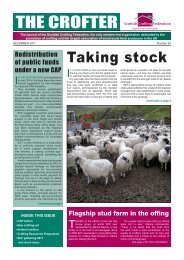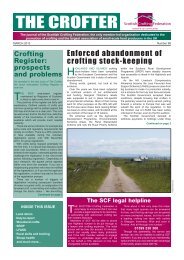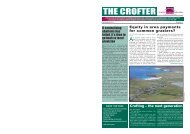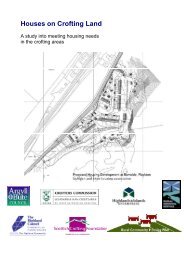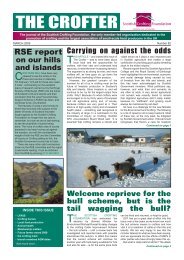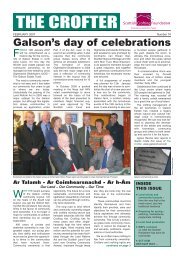THE CROFTER - Scottish Crofting Federation
THE CROFTER - Scottish Crofting Federation
THE CROFTER - Scottish Crofting Federation
You also want an ePaper? Increase the reach of your titles
YUMPU automatically turns print PDFs into web optimized ePapers that Google loves.
6<br />
crofting resources programme<br />
Crofters’ produce on Great British Menu<br />
H<br />
eading-up a great<br />
cast of top British chefs,<br />
Michael Smith, head<br />
chef at Skye’s legendary Three<br />
Chimneys Restaurant, appeared<br />
in the fifth series of BBC2’s Great<br />
British Menu in April.<br />
The competition to represent<br />
Scotland at a royal banquet hosted<br />
by Prince Charles in June was<br />
fierce, in what the BBC described<br />
as its toughest contest yet.<br />
Each chef was assigned to a<br />
National Trust estate, with the remit<br />
to source all of the ingredients for<br />
the menus from local farmers,<br />
crofters, fishermen and growers.<br />
The Balmacara estate was<br />
Michael Smith with Morag MacKenzie<br />
selected for Michael, from where<br />
he created an amazing menu.<br />
As Balmacara is the only National<br />
Trust property associated with<br />
crofting, Michael was determined<br />
that his menu should reflect the<br />
traditions of this unique way of life.<br />
The programme highlighted<br />
Michael’s visits to the local<br />
producers in the Balmacara<br />
area. Beef came from wellknown<br />
Duirinish crofter Morag<br />
MacKenzie, Hebridean lamb<br />
from Carol Anne and David<br />
Stewart at Balmacara; and<br />
Alex and Lennis Townsend<br />
supplied eggs, vegetables<br />
and soft fruit from their croft in<br />
Driving the bull out<br />
Alan Bush reminisces<br />
H<br />
ere is a bad photo of me<br />
driving the Department bull<br />
out in 1971.<br />
We used to winter the bulls in<br />
those days and they were hardy<br />
enough to survive such a life.<br />
They were much smaller than<br />
modern ones too.<br />
Neither was it the fashion<br />
to buy in much feed in those<br />
days and the stock was really<br />
fed from the croft – not as now<br />
just on the croft with bought and<br />
brought-in feed.<br />
Times change, but I doubt if<br />
they are likely to change back until<br />
transport breaks down a bit more.<br />
There was an old man in<br />
Badluachrach who told me<br />
of some of his experiences<br />
droving to Dingwall, and back<br />
sometimes if his boss the factor<br />
in Gruinard happened to fancy<br />
there was a bob or two to be<br />
made on a couple of pens of<br />
sheep. I don’t remember him<br />
speaking of cattle.<br />
Incidentally we used to drove<br />
both the sheep and cattle to<br />
Dundonnell or Eilean Darroch for<br />
the sales into the 1980s.<br />
Plockton. Mussels came from<br />
Peter MacAskill, Drumfearn<br />
and dairy products from<br />
the West Highland Dairy,<br />
Achmore. Michael was also<br />
determined to showcase<br />
Scotland’s culinary heritage<br />
by incorporating some modern<br />
takes on old ideas. Not only<br />
did he feature his version of a<br />
Scotch pie, but also included<br />
tattie scones, neeps, barley<br />
and handmade lamb’s haggis,<br />
the most delicate shortbread<br />
and green ginger jelly, pickled<br />
winkles and wild leaves.<br />
Michael said, “Some of our most<br />
widely-known dishes deserve to<br />
be celebrated as part of our rich<br />
food culture. I wanted to take this<br />
opportunity to bring them to the<br />
widest possible audience and<br />
take pride in proving the genuine<br />
provenance of the delicious food<br />
that is available for <strong>Scottish</strong> chefs<br />
like me, to cook and serve in our<br />
restaurants. We are blessed with<br />
the most wonderful, natural larder<br />
here on our doorstep in Skye<br />
and Lochalsh and The Three<br />
Chimneys has built its reputation<br />
upon sourcing local ingredients<br />
and taking pride in <strong>Scottish</strong><br />
cooking over many years.”<br />
As we went to press we heard<br />
that Michael did not go through<br />
to represent Scotland in the<br />
Great British Menu. The result<br />
was a travesty as his opponent<br />
used only 50 per cent local<br />
produce as against Michael’s<br />
90 per cent. The judges, a panel<br />
of London restaurant luvvies,<br />
obviously missed the whole<br />
point. However, we congratulate<br />
Michael Smith for presenting<br />
such wonderful food using the<br />
best of crofters’ produce.<br />
<strong>THE</strong> <strong>CROFTER</strong>, MAY 2010<br />
The peats<br />
Donald Murdie confesses<br />
to one of his favourite<br />
occupations<br />
S<br />
ince around the New<br />
Year, whenever we drive<br />
over the hill road I’ve<br />
been saying to my wife, “It’ll<br />
soon be time to turf the peats.”<br />
She responds with a sigh as<br />
the prospect of a day off recedes<br />
further into the distance. I admit<br />
it, I’m a bit weird. I actually enjoy<br />
the peats. I enjoy cutting them,<br />
lifting them, carrying them to<br />
the road, taking them home<br />
and, above all, burning them.<br />
I’ll soon be getting the tarasgeir<br />
out of the shed (where it<br />
hangs next to the scythe!) and<br />
sharpening and oiling it. The<br />
turfing spade will be sharpened<br />
too, and on the first decent day<br />
I’ll be out on the bank, mobile<br />
phone turned off, listening to<br />
the skylarks.<br />
Like a lot of crofting activity,<br />
the peats are associated<br />
with backbreaking work and<br />
a desperate need to survive<br />
which thankfully has passed.<br />
In certain areas such as north<br />
Lewis folk spent the whole<br />
summer, as soon as lambing<br />
was over and potatoes were<br />
planted, doing the peats.<br />
They worked round the whole<br />
township in co-operative<br />
reciprocal labour, ensuring<br />
a supply for the elderly and<br />
infirm as well as the active. In<br />
true Hebridean tradition, the<br />
technical work on the peat<br />
iron was done by the men,<br />
while the women performed<br />
the dirty and more physically<br />
demanding job of ‘throwing’,<br />
somehow managing to remain<br />
immaculate in skirt, apron,<br />
wellies and rubber gloves.<br />
The minister’s peats would be<br />
cut by the congregation, even<br />
if the cleric was able bodied<br />
and with a young family. So<br />
peat cutting became a drudge<br />
that most people were glad<br />
to see the back of. In the last<br />
couple of years, though, there<br />
have been signs of revival.<br />
Unprecedented oil prices have<br />
led to a stream of orders for<br />
peat irons being placed with<br />
the legendary Stornoway<br />
blacksmith, Calum Stallag. The<br />
secret of modern peat cutting<br />
is to take it in easy stages. The<br />
whole bank doesn’t have to<br />
be cut in one go. What’s been<br />
cut one weekend can often be<br />
lifted the next given half-decent<br />
weather, then some more cut,




